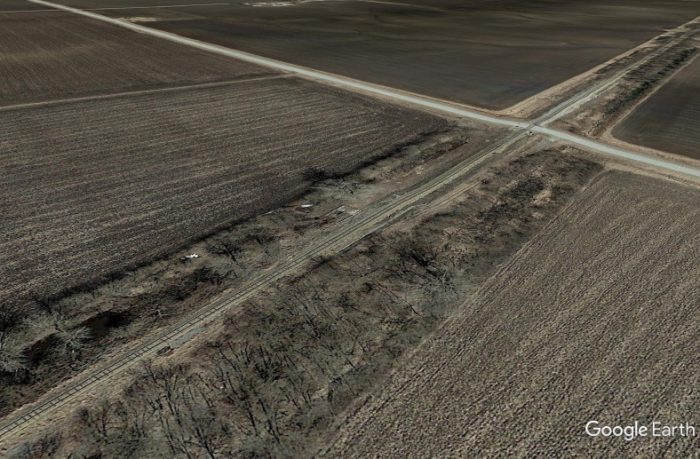If you are driving on the road crossing the railroad line north of Franklin, IL you will see nothing but train tracks and fields. It’s just a grade level crossing between farms. The view from the train traveling that section of track reveals the same. But close up, on the ground, you can kick around a 1700 square foot foundation of an old railroad station. Yeomans Depot.
This was a functioning train station 100 years ago. You would not surmise from its current condition that it was the scene of a love story – a love story that had to happen in order for these words to reach you now.
—
1869 was a momentous year in the life of Sjelf Anders. He was 17 and that was the year he emigrated from his home near the Swedish mining town of Falun to the United States. Settling in the budding Swedish community in Galva, IL he began work in the local coal mines. By 1880 he was naturalized (under the name Charles Erickson), married, and living in Bloomington, IL.
Although it’s not known exactly what brought him to Bloomington, he may have been part of a crew of Swedish coal miners recruited (unwittingly as strike-breakers as it turned out) from Galva in 1872 to work at the McLean County Coal Mine on the west side of town.
Work in the mines was dirty and dangerous. The local newspaper printed accounts of gruesome accidents, deaths and maimings. “Death came to Jacob Osman, vast in fantastic horrors,” read one headline from 1899. The description of the accident completely justifies the alarming headline.
Fortunately, for the benefit of Charles’ future family, he found work as a fireman at the Chicago and Alton Railroad yard and was able to leave the coal mines. There he continued to work for close to 50 years while raising his family in the home he bought just blocks away.
His wife-to-be immigrated from Falun in 1878. They were married in 1879 and over a period of 15 years had nine children. Victor, the second youngest was born in 1893. He attended school until 8th grade and then began his own work at the railroad yard. During his career with C&A he was a machinist, a foreman and sometimes a baggage man, traveling the route past the Yeomans station..
The farm abuting the station to the north was owned by the Turleys – Felix and Cordelia. They were first cousins, married in 1882 at the ages of 19 and 16 respectively. Felix and Cordelia could trace some of their shared lineage back 8 generations to early settlers in the Tidewater Virginia region.
One set of their 4th great grandparents, the Strothers, owned a tobacco farm across the Rappahannock River from the town of Fredericksburg in Virginia. When William Strother died in 1732 the farm was sold to Augustine Washington and it became the boyhood home of George Washington, our future President. As a note to the curious: subsequent excavations on the property have yielded no evidence of the fabled cherry tree.
The immediate families of Felix and Cordelia arrived in Morgan County at the end of a decades-long migration from their home countries of Ireland, Scotland and England through routes that started in Virginia, went south through the Shenandoah Valley, and passed through Kentucky, Tennessee and finally westward to Illinois where they made their lives as farmers.
Their first two children were still-born twins, and they had four children after that. Belva was the second youngest, born in 1896.
All of the children worked on the farm as soon as they were able. They could see the train passing by Yeomans Depot from the fields.
During one of those passages, somewhere in the 1916 time frame, there was a moment at which Victor the Swedish baggageman and Belva, the farmer’s daughter whose ancestors had followed the Scotch-Irish migration from America’s eastern shores to the midwest, caught each other’s gaze as the train travelled past. That was the moment Victor knew, as he once explained to his young grandson (who was mostly unappreciative at the time of the import of the story), that he was going to marry Belva one day. He was smitten. And so it happened. After a courtship ritual that remains undocumented, they were married in 1917 in Victor’s hometown of Bloomington.
Victor continued to work on the C&A railroad while Belva stayed at home with their three children. One died at age 12 from scarlet fever. One joined the Army, fought the Japanese in Guam, and returned to the family home, never to set out on his own. The third, my mother, left Bloomington at 18. She spent two years in college and then traveled to Denver to join a friend. She got a job with the War Department, met her future husband and began her own family with him in Denver.
Victor died in 1980. My mother attended to the closing of his house and his estate. She drove down to Yeomans Depot and took a picture. It’s blurry. The station is still standing but it’s impossible to tell if it’s still in use. She wrote on the back of the picture an abbreviated version of this account – a reminder to her descendents (and perhaps to herself) of the meaning of this nondescript crossing in the middle of Illinois farms.
My grandfather told this story to me many times. It was important to him, and important to my mother. And now, it’s important to me as well. It’s a reminder that our own lives are part of a miraculous web of connections. And once in a while they transcend the everyday temporal and become the lore that fuels the meaning and creates the context of our world view.
These stories deserve to be told and celebrated. Do you have your own to tell?







Read 2 comments and reply